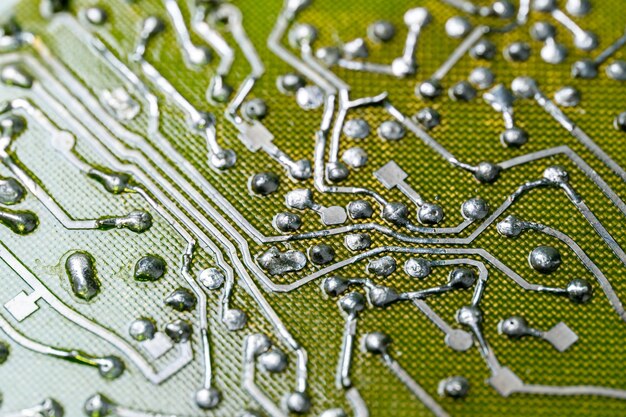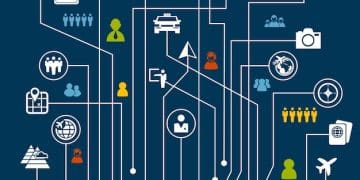US Economic Growth: Historical Trends & 2025 Forecast

Analyzing the Historical Trends of US Economic Growth and Their Implications for 2025 reveals critical insights into long-term patterns, technological impacts, policy effects, and global influences, aiding in forecasting economic performance and informing strategic decision-making for the future.
Understanding the trajectory of the US economy requires a close examination of its past. By analyzing the historical trends of US economic growth and their implications for 2025, we can better anticipate future challenges and opportunities, informing policy decisions and investment strategies.
A Century of US Economic Expansion: An Overview
The economic history of the United States is marked by periods of robust growth, punctuated by recessions and significant structural changes. Examining the growth patterns of the last century provides a valuable framework for understanding present conditions and forecasting future trends.
From the industrial boom of the early 20th century to the post-war expansion and the tech-driven growth of the late 20th and early 21st centuries, each era has contributed uniquely to the economic landscape of the US.
Key Eras of Economic Development
Several distinct phases characterize US economic history, each with its own set of drivers and characteristics. Consider the roaring 20s or the post-war boom as examples of periods with unique impetuses.
- Early 20th Century Industrialization: Characterized by rapid industrial growth and urbanization.
- The Great Depression: A period of severe economic contraction and social upheaval.
- Post-World War II Boom: Marked by suburbanization, technological innovation, and increased consumer spending.
- The Tech Boom: Fueled by the internet, personal computers, and globalization.
These eras not only define the economic narrative but also shape the underlying structures and policies that affect current economic performance.
In conclusion, a broad look at the last century highlights the resilience and adaptability of the US economy, laying the groundwork for deeper analysis of specific trends and future expectations.
Technological Revolutions and Economic Growth
Technology has consistently served as a primary engine of economic growth in the US. The introduction of new technologies often leads to increased productivity, new industries, and profound shifts in employment patterns.
Understanding the impact of technological advancements is crucial for predicting future economic trends, particularly in the context of globalization and rapid digital transformation.

The Impact of Key Innovations
Certain technological milestones have had a disproportionately large impact on the US economy. As innovations arise, adoption and adaptation often dictate the magnitude of their effect.
- The Rise of the Internet: Transformed communication, commerce, and information access.
- Automation and Robotics: Increased efficiency but also raised concerns about job displacement.
- Artificial Intelligence: Potential to revolutionize numerous sectors, from healthcare to finance.
- Biotechnology: Offering new opportunities in medicine, agriculture, and environmental management.
These innovations have not only created new wealth but also redefined the skills and education needed to thrive in the modern workforce.
Technological change remains a pivotal factor in economic forecasting, requiring policymakers and businesses to stay ahead of the curve. As these innovations continue to evolve, their integration into the economy will directly shape growth patterns and potential.
Fiscal and Monetary Policy: Shaping the Economic Landscape
Government policies, particularly fiscal and monetary measures, significantly influence the pace and direction of economic growth. These policies are designed to manage inflation, unemployment, and overall economic stability.
The effectiveness of these policies often depends on the economic context and the ability of policymakers to adapt to changing conditions and unforeseen events.
Key Policy Levers
Governments employ a variety of tools to influence the economy. How these tools are used can have significant impacts on growth and stability.
- Interest Rate Adjustments: Managed by the Federal Reserve to control inflation and stimulate growth.
- Government Spending: Influences aggregate demand and investment in infrastructure and social programs.
- Tax Policies: Impact consumer spending, business investment, and income distribution.
- Regulatory Frameworks: Shape competition, innovation, and environmental sustainability.
The interplay between these policy levers and economic dynamics can lead to either sustained growth or periods of instability.
In conclusion, fiscal and monetary policies are indispensable tools that, when wielded effectively, can contribute to a stable and growing US economy. Monitoring and adjusting these policies in response to economic indicators remains a critical task for policymakers.
Globalization and its Effect on US Economic Growth
Globalization has profoundly reshaped the US economy, increasing trade, investment, and competition. While it offers access to new markets and resources, it also presents challenges for domestic industries and workers.
Understanding the complexities of globalization is essential for navigating the changing dynamics of the international economy and harnessing its benefits while mitigating its risks.

Opportunities and Challenges of Global Integration
Greater integration into the global economy brings both potential benefits and risks. Balancing these factors is critical for maximizing economic welfare.
- Increased Trade: Access to cheaper goods and larger markets.
- Foreign Investment: Stimulates economic activity and innovation.
- Competition: Drives efficiency and lowers prices but can also result in job losses.
These dynamics necessitate strategic policy responses to ensure that the benefits of globalization are broadly shared and that vulnerable sectors receive adequate support.
In conclusion, globalization continues to be a double-edged sword for the US economy. Success in this increasingly interconnected world requires proactive policies that promote competitiveness, innovation, and worker adaptation.
Demographic Changes and Labor Force Dynamics
Demographic shifts, such as aging populations and changing immigration patterns, significantly affect the labor force and economic growth. These changes influence workforce participation rates, skill sets, and consumer demand.
Adapting to these demographic realities is crucial for maintaining economic competitiveness and ensuring social equity.
The Shifting Demographics of the US
The changing composition of the US population presents both opportunities and challenges for the economy. Recognizing these patterns is critical for policy-making.
The US population is aging. As the Baby Boomer generation retires, there’s a potential decline in labor force participation, affecting economic output.
Immigration patterns are shifting. Changes in immigration policies and global migration trends influence the size and composition of the workforce.
Education levels are rising. An increasingly educated workforce can drive innovation and productivity growth.
These demographic trends collectively shape the economic landscape, influencing consumer behavior, labor supply, and the demand for various goods and services.
In summary, understanding and responding to demographic changes is crucial for fostering a dynamic and inclusive economy that can meet the challenges of the future.
Forecasting US Economic Growth: Implications for 2025
Looking ahead to 2025, several factors will likely shape the US economic landscape. These include technological advancements, policy decisions, global economic conditions, and demographic trends.
Developing accurate forecasts requires integrating these diverse factors and considering various possible scenarios to inform strategic planning and policy interventions.
Economic Projections and Key Indicators
Various economic indicators can provide insights into the potential performance of the US economy in 2025. These are some elements to watch:
GDP Growth expectations for 2025 hinge on sustained technological innovation and a steady recovery of consumer spending.
Employment rates are likely to be influenced by automation and the demand for skilled workers in emerging industries.
Inflation rates will depend on monetary policy decisions and supply chain resilience.
Trade balances: Global trade dynamics and geopolitical factors will continue to impact imports and exports.
These indicators, when interpreted in conjunction with historical trends and current economic conditions, offer a valuable basis for forecasting US economic growth in 2025 and beyond.
To conclude, the path forward for the US economy in 2025 depends on proactive strategies that leverage technological advances, address demographic shifts, and navigate the complexities of globalization. By integrating these factors into economic forecasting and policy-making, stakeholders can better position the US for sustained and inclusive growth.
| Key Point | Brief Description |
|---|---|
| 🚀 Tech Innovation | Drives productivity and creates new economic sectors. |
| 🌍 Globalization | Shapes trade, investment, and competition profoundly. |
| 🎯 Fiscal Policy | Manages inflation, unemployment, and economic stability. |
| 👴 Demographics | Affects labor force size, skills, and consumer demand. |
Frequently Asked Questions
▼
Industrialization, technological innovation, and increased consumer spending were key drivers. The post-World War II boom and the tech revolution also played significant roles in boosting economic growth.
▼
Globalization increases trade, investment, and competition. While it offers access to new markets and resources, it also poses challenges to domestic industries and can lead to job displacement.
▼
Fiscal policies (government spending and taxation) and monetary policies (managed by the Federal Reserve) influence inflation, unemployment, and overall economic stability. They are essential for managing economic cycles.
▼
Demographic shifts, such as aging populations and changing immigration patterns, influence the labor force size, skill sets, and consumer demand. Adapting to these demographic realities is vital for economic competitiveness.
▼
Key factors: GDP growth expectations, employment rates, inflation rates, and trade balances. Also important are technological innovation, policy decisions, and global economic conditions.
Conclusion
In conclusion, analyzing the historical trends of US economic growth and their implications for 2025 reveals the complex interplay of technological innovation, policy decisions, globalization, and demographic shifts. By integrating these diverse factors into economic forecasting and strategic planning, stakeholders can better prepare the US for a future of sustained and inclusive growth, ensuring improved economic outcomes for all.





